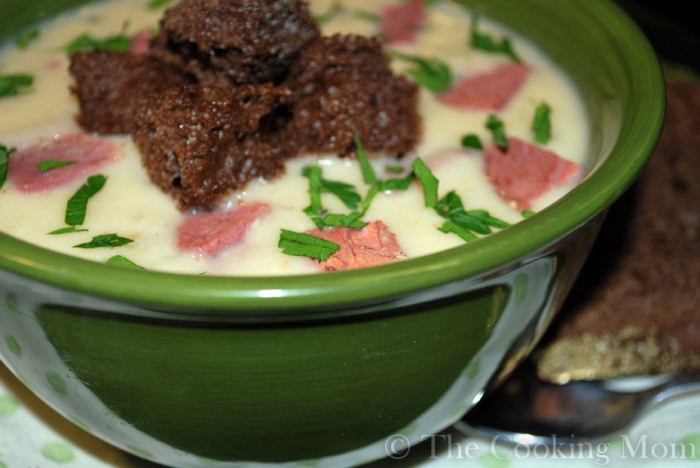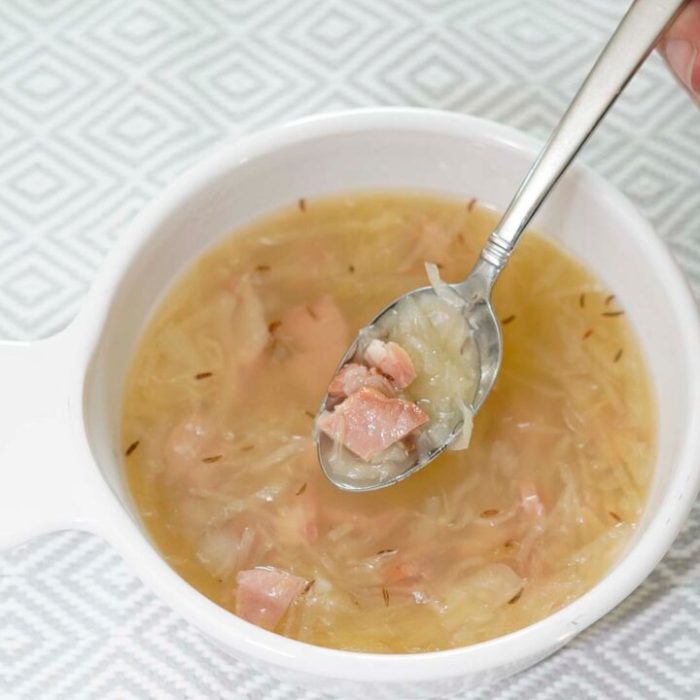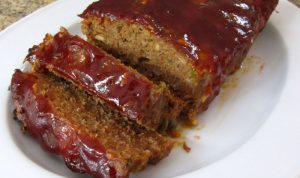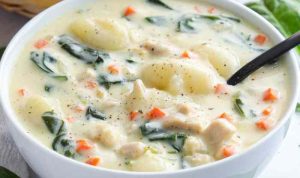Reuben Soup Recipe Variations
Reuben soup recipe – Reuben soup, a comforting and flavorful twist on the classic Reuben sandwich, offers a delightful culinary experience. Its rich and savory profile stems from the harmonious blend of corned beef, sauerkraut, Swiss cheese, and Thousand Island dressing. The versatility of this soup allows for various cooking methods, each imparting unique characteristics to the final product.
Stovetop Reuben Soup
This method provides a quick and easy way to enjoy Reuben soup. The direct heat allows for precise control over the cooking process, resulting in a soup with a vibrant flavor and tender corned beef. The sauerkraut retains its pleasant tang, while the Swiss cheese melts seamlessly into the broth, creating a creamy texture.
Slow Cooker Reuben Soup
The slow cooker method yields a deeply flavorful soup. The long, low-heat cooking allows the ingredients to meld together beautifully, creating a rich and complex taste. The corned beef becomes exceptionally tender, and the sauerkraut develops a more mellow, less acidic flavor. The slow cooking process infuses the entire soup with a nuanced depth of flavor not easily replicated with other methods.
Instant Pot Reuben Soup, Reuben soup recipe
For a faster approach, the Instant Pot offers a convenient and efficient way to prepare Reuben soup. Pressure cooking tenderizes the corned beef quickly while maintaining the integrity of the other ingredients. The resulting soup boasts a bold flavor, with the sauerkraut retaining its characteristic tang and the Swiss cheese melting smoothly into the broth. This method is ideal for busy weeknights.
Reuben Soup Recipe Comparison
| Recipe Method | Cooking Time | Difficulty | Flavor Profile |
|---|---|---|---|
| Stovetop | 30-45 minutes | Easy | Bright, vibrant, slightly tangy |
| Slow Cooker | 6-8 hours on low | Easy | Rich, deep, mellow |
| Instant Pot | 20-25 minutes | Easy | Bold, flavorful, tangy |
Key Ingredients and Substitutions
Understanding the role of each ingredient is crucial to crafting the perfect Reuben soup. Each component contributes significantly to the overall flavor profile. However, substitutions are possible to accommodate dietary needs or personal preferences.
Role of Core Ingredients

Source: thecookingmom.com
Corned beef provides the signature savory saltiness; sauerkraut offers a tangy counterpoint; Swiss cheese lends a nutty, creamy richness; and Thousand Island dressing contributes a creamy, slightly sweet and tangy element. The interplay of these flavors creates the unique Reuben experience.
Ingredient Substitutions
While traditional ingredients are preferred, alternatives can be used. These substitutions might alter the flavor profile, but can still result in a delicious soup.
| Ingredient | Alternative 1 | Alternative 2 | Alternative 3 |
|---|---|---|---|
| Corned Beef | Pastrami | Smoked Beef Brisket | Cooked Chicken |
| Sauerkraut | Kimchi | Pickled Cabbage | Dill Pickles (finely chopped) |
| Swiss Cheese | Provolone | Gruyere | Monterey Jack |
| Thousand Island Dressing | French Dressing | Mayonnaise | Ranch Dressing |
Dietary Substitutions
- Vegetarian: Replace corned beef with hearty mushrooms, lentils, or roasted vegetables.
- Vegan: Use plant-based corned beef alternatives (available commercially), replace cheese with nutritional yeast, and use a vegan mayonnaise-based dressing.
- Gluten-Free: Ensure that all broths and seasonings used are gluten-free.
Serving Suggestions and Enhancements
Serving Reuben soup is an opportunity to elevate the presentation and enhance the flavor profile. Creative garnishes and accompaniments can transform a simple bowl of soup into a visually appealing and delicious meal.
Serving Suggestions
- Garnish with a dollop of sour cream or crème fraîche and fresh dill.
- Serve with crusty bread for dipping.
- Add a side of pickled onions or jalapeños for extra zest.
- Top with crispy fried onions for added texture and flavor.
- Serve in bread bowls for a hearty and visually appealing presentation.
Plating and Garnishes
For an elegant presentation, serve the soup in shallow bowls. A swirl of crème fraîche or a sprinkle of fresh herbs (such as chives or parsley) can add visual appeal. A few croutons or a small side of rye bread also enhance the presentation.
Flavor Enhancements
Experimenting with spices and herbs can deepen the Reuben soup’s flavor. A dash of caraway seeds or a pinch of smoked paprika adds warmth and complexity. Fresh dill or thyme can contribute a refreshing herbaceous note.
Nutritional Information and Dietary Adaptations: Reuben Soup Recipe
While Reuben soup is undeniably delicious, it’s important to be mindful of its nutritional content. Adjustments can be made to reduce sodium, fat, or calories, without sacrificing flavor.
Nutritional Information (per serving – approximate)
| Nutrient | Amount |
|---|---|
| Calories | 350-450 |
| Fat | 20-25g |
| Protein | 25-30g |
| Carbohydrates | 20-30g |
Dietary Adaptations
- Lower Sodium: Use low-sodium corned beef and broth. Rinse the sauerkraut before adding it to the soup.
- Lower Fat: Use leaner cuts of corned beef. Reduce the amount of cheese and dressing.
- Lower Calories: Use smaller portions of corned beef and cheese. Increase the amount of vegetables in the soup.
Nutritional Benefits
Corned beef is a good source of protein; sauerkraut provides probiotics; Swiss cheese offers calcium; and the vegetables contribute vitamins and fiber. A balanced approach ensures the soup remains a nutritious part of a healthy diet.
Historical Context and Cultural Influences
Reuben soup’s origins are closely tied to the classic Reuben sandwich. While the exact origins of the sandwich are debated, its popularity led to creative culinary adaptations, including the soup version. The soup reflects the evolution of American cuisine, incorporating elements from various culinary traditions.
Origins and Connections

Source: coupleinthekitchen.com
Reuben soup is a relatively recent culinary creation, inspired by the beloved Reuben sandwich. Its emergence likely reflects a desire to enjoy the classic Reuben flavors in a different format, offering a warm and comforting alternative.
While a Reuben soup recipe typically features hearty ingredients like corned beef and sauerkraut, a completely different flavor profile emerges with a lighter, vegetable-based broth. For a contrasting culinary experience, consider exploring the delicate flavors of a recipe for korean tofu soup , which offers a refreshing change of pace. Then, you can appreciate the richness of your Reuben soup recipe even more.
Cultural Influences

Source: tasteofhome.com
The soup’s ingredients—corned beef (of Eastern European origin), sauerkraut (of German origin), Swiss cheese (of Swiss origin), and Thousand Island dressing (of American origin)—represent a fusion of culinary traditions. This reflects the multicultural nature of American cuisine.
Regional Variations
Regional variations might include the type of corned beef used, the style of sauerkraut, or the addition of local ingredients. These variations demonstrate the adaptability and regional interpretations of this dish.
Troubleshooting Common Issues
While Reuben soup is relatively straightforward, certain issues can arise during preparation. Understanding the causes of these problems and implementing solutions ensures a consistently delicious outcome.
Common Problems and Solutions
- Overly Salty: This is often caused by using overly salty corned beef or broth. Solution: Rinse the corned beef before cooking, use low-sodium broth, and adjust seasoning carefully.
- Too Thick: This can result from using too much cheese or not enough liquid. Solution: Add more broth or water to thin the soup. Reduce the amount of cheese used.
- Bland: This might indicate insufficient seasoning or a lack of balance in flavors. Solution: Add more spices, herbs, or a touch of acidity (like lemon juice) to enhance the taste.
Troubleshooting Tips
- Taste and adjust seasoning throughout the cooking process.
- Don’t overcook the corned beef, as it can become tough.
- Ensure proper balance between salty, tangy, and creamy elements.
- Allow the soup to simmer for a while to allow flavors to meld.
FAQ Insights
Can I make Reuben soup ahead of time?
Yes, Reuben soup tastes even better the next day! Store leftovers in an airtight container in the refrigerator for up to 3 days.
What type of sauerkraut is best for Reuben soup?
Use a good quality sauerkraut, either fermented or unfermented, depending on your preference. Avoid overly sweet or artificially flavored varieties.
Can I freeze Reuben soup?
Yes, you can freeze Reuben soup for up to 3 months. Allow it to thaw completely in the refrigerator before reheating.
Is Reuben soup gluten-free?
The base recipe can be gluten-free, but be sure to check the labels of all ingredients, especially the broth and Thousand Island dressing, for gluten-containing additives.






